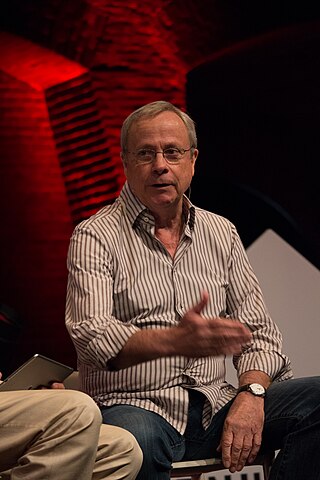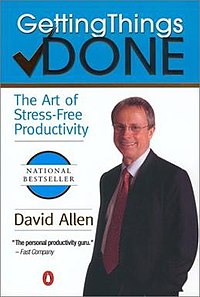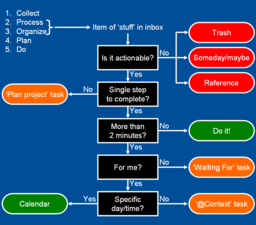Time management is the process of planning and exercising conscious control of time spent on specific activities — especially to increase effectiveness, efficiency, and productivity.

A collaboration tool helps people to collaborate. The purpose of a collaboration tool is to support a group of two or more individuals to accomplish a common goal or objective. Collaboration tools can be either of a non-technological nature such as paper, flipcharts, post-it notes or whiteboards. They can also include software tools and applications such as collaborative software.

David Allen is an American author and productivity consultant. He created the time management method Getting Things Done.

A checklist is a type of job aid used in repetitive tasks to reduce failure by compensating for potential limits of human memory and attention. Checklists are used both to ensure that safety-critical system preparations are carried out completely and in the correct order, and in less critical applications to ensure that no step is left out of a procedure. they help to ensure consistency and completeness in carrying out a task. A basic example is the "to do list". A more advanced checklist would be a schedule, which lays out tasks to be done according to time of day or other factors, or a pre-flight checklist for an airliner, which should ensure a safe take-off.

A tickler file or 43 Folders System is a collection of date-labeled file folders organized in a way that allows time-sensitive documents to be filed according to the future date on which each document needs action. Documents within the folders of a tickler file can be to-do lists, pending bills, unpaid invoices, travel tickets, hotel reservations, meeting information, birthday reminders, coupons, claim tickets, call-back notes, follow-up reminders, maintenance reminders, or any other papers that require future action. Each day, the folder having the current date is retrieved from the tickler file so that any documents within it may be acted on. Essentially, a tickler file provides a way to send a reminder to oneself in the future—"tickling" one's memory.

Merlin Dean Mann III is an American writer, blogger, and podcaster.

OmniFocus is a personal task manager by the Omni Group for macOS and iOS. The declared goal of the program is to be able to capture thoughts and ideas into to do lists. The program uses concepts and techniques described in the book and productivity system called Getting Things Done (GTD) by David Allen.

Things is a task management app for macOS, iPadOS, iOS, watchOS, and visionOS made by Cultured Code, a software startup based in Stuttgart, Germany. It first released for Mac as an alpha that went out in late 2007 to 12,000 people and quickly gained popularity. The following July, when the App Store launched, it was among the first 552 apps available for iPhone. It was then released alongside the iPad in 2010, the Apple Watch in 2015, and the Apple Vision Pro in 2024.
ManagePro is a project and performance management software product produced by Angbert Enterprises LLC, a US software and IT consulting company headquartered in Downey, California.

A kanban board is one of the tools that can be used to implement kanban to manage work at a personal or organizational level.
Activity management is the process of recording everything a worker does throughout a typical day, in the order that it is done, all while labeling their activity correctly. Tracking the progress of what is done by each worker in a typical day is becoming increasingly complex as organizations grow, both internally and externally. Activity management systems create an easily accessible format for tracking the performance of both employees and employers.
Digital collaboration is using digital technologies for collaboration. Dramatically different from traditional collaboration, it connects a broader network of participants who can accomplish much more than they would on their own. Digital Collaboration is used in many fields, for example digital collaboration in classrooms.
TaskCracker for Outlook is a Microsoft Outlook add-in for task- and time-management. It allows managing tasks visually within Microsoft Outlook interface. It is based on the Eisenhower Method of arranging tasks by urgency and importance. It is also loosely based on David Allen's Getting Things Done methodology of improving productivity.
IQTELL was a productivity app that allowed users to manage email, tasks, projects, calendars, contacts, Evernotes and more in a single app. IQTELL was available as a web app, as well as an iOS and Android app. All user information was automatically synced between all devices. iOS and Android apps supported offline access. The app could be used to implement concepts and techniques described in the book Getting Things Done by David Allen.

Inbox by Gmail was an email service developed by Google. Announced on a limited invitation-only basis on October 22, 2014, it was officially released to the public on May 28, 2015. Inbox was shut down by Google on April 2, 2019.
Acompli is a discontinued mobile app that allowed for user interaction with email messages as well as management of multiple email accounts in one programme. In addition, the tool also organized one's calendar and shared files. This application provided for integration with cloud storage platforms such as Dropbox, OneDrive, and iCloud; it also carried support for Microsoft Exchange and Gmail. Acompli launched on 24 April 2014. The startup company, which had $7.3 million in funding, was led by CEO Javier Soltero, J.J. Zhuang (CTO) and Kevin Henrikson.

Pyrus is a cloud-based workflow automation and document management system developed by Simply Good Software, Inc. Pyrus comes as SaaS and offers a web-based interface to launch workflows, assign tasks, and manage documents. It is a unified corporate communication environment, accessible from any device. Mobile versions are available for all platforms, including iOS, Android, and Android Wear. Users are able to set up and route workflows without coding and IT assistance.

Chris Bailey is a Canadian writer and productivity consultant, and the author of The Productivity Project (2016), Hyperfocus (2018) and How to Calm Your Mind (2022).
Timeblocking or time blocking is a productivity technique for personal time management where a period of time—typically a day or week—is divided into smaller segments or blocks for specific tasks or to-dos. It integrates the function of a calendar with that of a to-do list. It is a kind of scheduling.

A list is a set of discrete items of information collected and set forth in some format for utility, entertainment, or other purposes. A list may be memorised in any number of ways, including existing only in the mind of the list-maker, but lists are frequently written down on paper, or maintained electronically. Lists are "most frequently a tool", and "one does not read but only uses a list: one looks up the relevant information in it, but usually does not need to deal with it as a whole".













